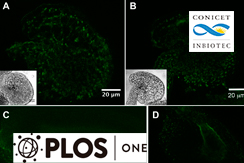La sacarosa es el principal azúcar producido en la plantas a partir de la fijación del dióxido de carbono del aire. La hidrólisis de la sacarosa conduce a la formación de glucosa y fructosa, fuente de carbono y energía para el crecimiento y desarrollo de la planta. En particular, las invertasas alcalino/neutras son proteínas que catalizan esta hidrólisis y que han sido ignoradas por largo tiempo en los estudios bioquímico/fisiológicos, tal vez porque estaban en baja concentración, presentaban actividad baja y eran muy lábiles cuando se las quería purificar. Nuestro laboratorio ha sido pionero en el estudio de estas proteínas de localización citosólica en trigo, tabaco y Arabidopsis y su relación en la respuesta a condiciones ambientales adversas.
El trabajo que se acaba de publicar en PlosOne demuestra la existencia de una forma de invertasa alcalino/neutra en la planta Arabidopsis que está localizada en las mitocondrias y que es muy importante en el desarrollo del tallo, en la floración, y en la respuesta a estrés oxidativo.
Plos One, 25 de septiembre de 2017
The riddle of mitochondrial alkaline/neutral invertases: A novel Arabidopsis isoform mainly present in reproductive tissues and involved in root ROS production
- Marina E. Battaglia
- M. Victoria Martin
- Leandra Lechner
- Giselle M. A. Martínez-Noël
- Graciela L. Salerno
Alkaline/neutral invertases (A/N-Inv), glucosidases that irreversibly hydrolyze sucrose into glucose and fructose, play significant roles in plant growth, development, and stress adaptation. They occur as multiple isoforms located in the cytosol or organelles. In Arabidopsis thaliana, two mitochondrial A/N-Inv genes (A/N-InvA and A/N-InvC) have already been investigated. In this study, we functionally characterized A/N-InvH, a third Arabidopsis gene coding for a mitochondrial-targeted protein. The phenotypic analysis of knockout mutant plants (invh) showed a severely reduced shoot growth, while root development was not affected. The emergence of the first floral bud and the opening of the first flower were the most affected stages, presenting a significant delay. A/N-InvH transcription is markedly active in reproductive tissues. It is also expressed in the elongation and apical meristem root zones. Our results show that A/N-InvH expression is not evident in photosynthetic tissues, despite being of relevance in developmental processes and mitochondrial functional status. NaCl and mannitol treatments increased A/N-InvH expression twofold in the columella root cap. Moreover, the absence of A/N-InvH prevented ROS formation, not only in invh roots of salt- and ABA-treated seedlings but also in invh control roots. We hypothesize that this isoform may take part in the ROS/sugar (sucrose or its hydrolysis products) signaling pathway network, involved in reproductive tissue development, cell elongation, and abiotic stress responses.
Palabras clave
- Arabidopsis Thaliana
- Mitochondria
- Sucrose
- Flowering plants
- Fluorescence imaging
https://doi.org/10.1371/journal.pone.0185286

